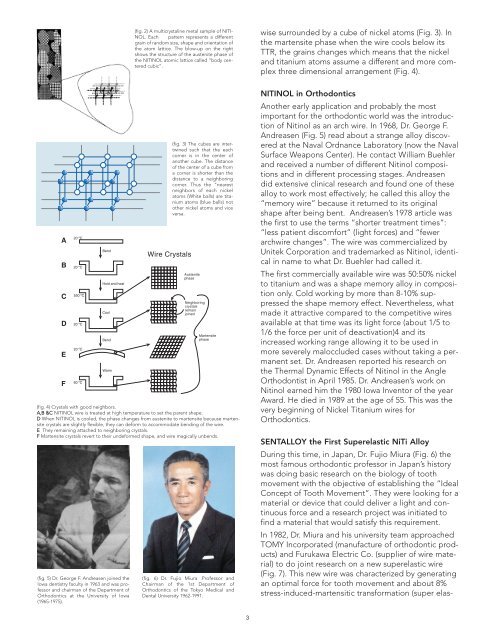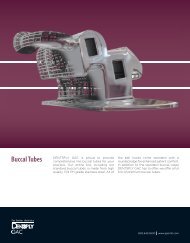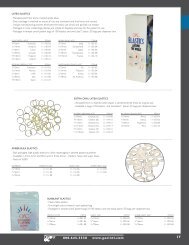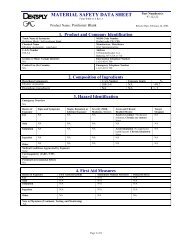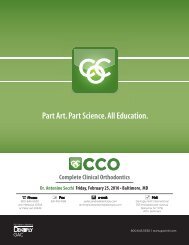SENTALLOY® - GAC International
SENTALLOY® - GAC International
SENTALLOY® - GAC International
You also want an ePaper? Increase the reach of your titles
YUMPU automatically turns print PDFs into web optimized ePapers that Google loves.
(fig. 2) A multicrystaline metal sample of NITI-<br />
NOL. Each pattern represents a different<br />
grain of random size, shape and orientation of<br />
the atom lattice. The blow-up on the right<br />
shows the structure of the austenite phase of<br />
the NITINOL atomic lattice called “body centered<br />
cubic”.<br />
(fig. 3) The cubes are intertwined<br />
such that the each<br />
corner is in the center of<br />
another cube. The distance<br />
of the center of a cube from<br />
a corner is shorter than the<br />
distance to a neighboring<br />
corner. Thus the “nearest<br />
neighbors of each nickel<br />
atoms (White balls) are titanium<br />
atoms (blue balls) not<br />
other nickel atoms and vice<br />
versa.<br />
(fig. 4) Crystals with good neighbors.<br />
A,B &C NITINOL wire is treated at high temperature to set the parent shape.<br />
D When NITINOL is cooled, the phase changes from austenite to martensite because martensite<br />
crystals are slightly flexible, they can deform to accommodate bending of the wire.<br />
E They remaining attached to neighboring crystals.<br />
F Martensite crystals revert to their undeformed shape, and wire magically unbends.<br />
(fig. 5) Dr. George F. Andreasen joined the<br />
Iowa dentistry faculty in 1963 and was professor<br />
and chairman of the Department of<br />
Orthodontics at the University of Iowa<br />
(1965-1975).<br />
(fig. 6) Dr. Fujio Miura .Professor and<br />
Chairman of the 1st Department of<br />
Orthodontics of the Tokyo Medical and<br />
Dental University 1962-1991.<br />
3<br />
wise surrounded by a cube of nickel atoms (Fig. 3). In<br />
the martensite phase when the wire cools below its<br />
TTR, the grains changes which means that the nickel<br />
and titanium atoms assume a different and more complex<br />
three dimensional arrangement (Fig. 4).<br />
NITINOL in Orthodontics<br />
Another early application and probably the most<br />
important for the orthodontic world was the introduction<br />
of Nitinol as an arch wire. In 1968, Dr. George F.<br />
Andreasen (Fig. 5) read about a strange alloy discovered<br />
at the Naval Ordnance Laboratory (now the Naval<br />
Surface Weapons Center). He contact William Buehler<br />
and received a number of different Nitinol compositions<br />
and in different processing stages. Andreasen<br />
did extensive clinical research and found one of these<br />
alloy to work most effectively; he called this alloy the<br />
“memory wire” because it returned to its original<br />
shape after being bent. Andreasen’s 1978 article was<br />
the first to use the terms “shorter treatment times”:<br />
“less patient discomfort” (light forces) and “fewer<br />
archwire changes”. The wire was commercialized by<br />
Unitek Corporation and trademarked as Nitinol, identical<br />
in name to what Dr. Buehler had called it.<br />
The first commercially available wire was 50:50% nickel<br />
to titanium and was a shape memory alloy in composition<br />
only. Cold working by more than 8-10% suppressed<br />
the shape memory effect. Nevertheless, what<br />
made it attractive compared to the competitive wires<br />
available at that time was its light force (about 1/5 to<br />
1/6 the force per unit of deactivation)4 and its<br />
increased working range allowing it to be used in<br />
more severely maloccluded cases without taking a permanent<br />
set. Dr. Andreasen reported his research on<br />
the Thermal Dynamic Effects of Nitinol in the Angle<br />
Orthodontist in April 1985. Dr. Andreasen’s work on<br />
Nitinol earned him the 1980 Iowa Inventor of the year<br />
Award. He died in 1989 at the age of 55. This was the<br />
very beginning of Nickel Titanium wires for<br />
Orthodontics.<br />
SENTALLOY the First Superelastic NiTi Alloy<br />
During this time, in Japan, Dr. Fujio Miura (Fig. 6) the<br />
most famous orthodontic professor in Japan’s history<br />
was doing basic research on the biology of tooth<br />
movement with the objective of establishing the “Ideal<br />
Concept of Tooth Movement”. They were looking for a<br />
material or device that could deliver a light and continuous<br />
force and a research project was initiated to<br />
find a material that would satisfy this requirement.<br />
In 1982, Dr. Miura and his university team approached<br />
TOMY Incorporated (manufacture of orthodontic products)<br />
and Furukawa Electric Co. (supplier of wire material)<br />
to do joint research on a new superelastic wire<br />
(Fig. 7). This new wire was characterized by generating<br />
an optimal force for tooth movement and about 8%<br />
stress-induced-martensitic transformation (super elas-


